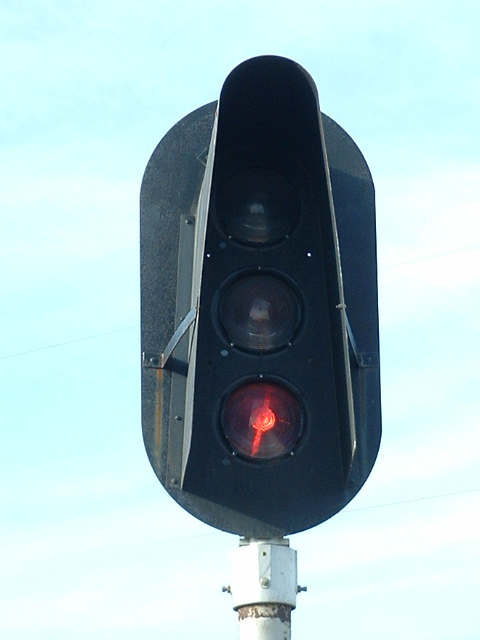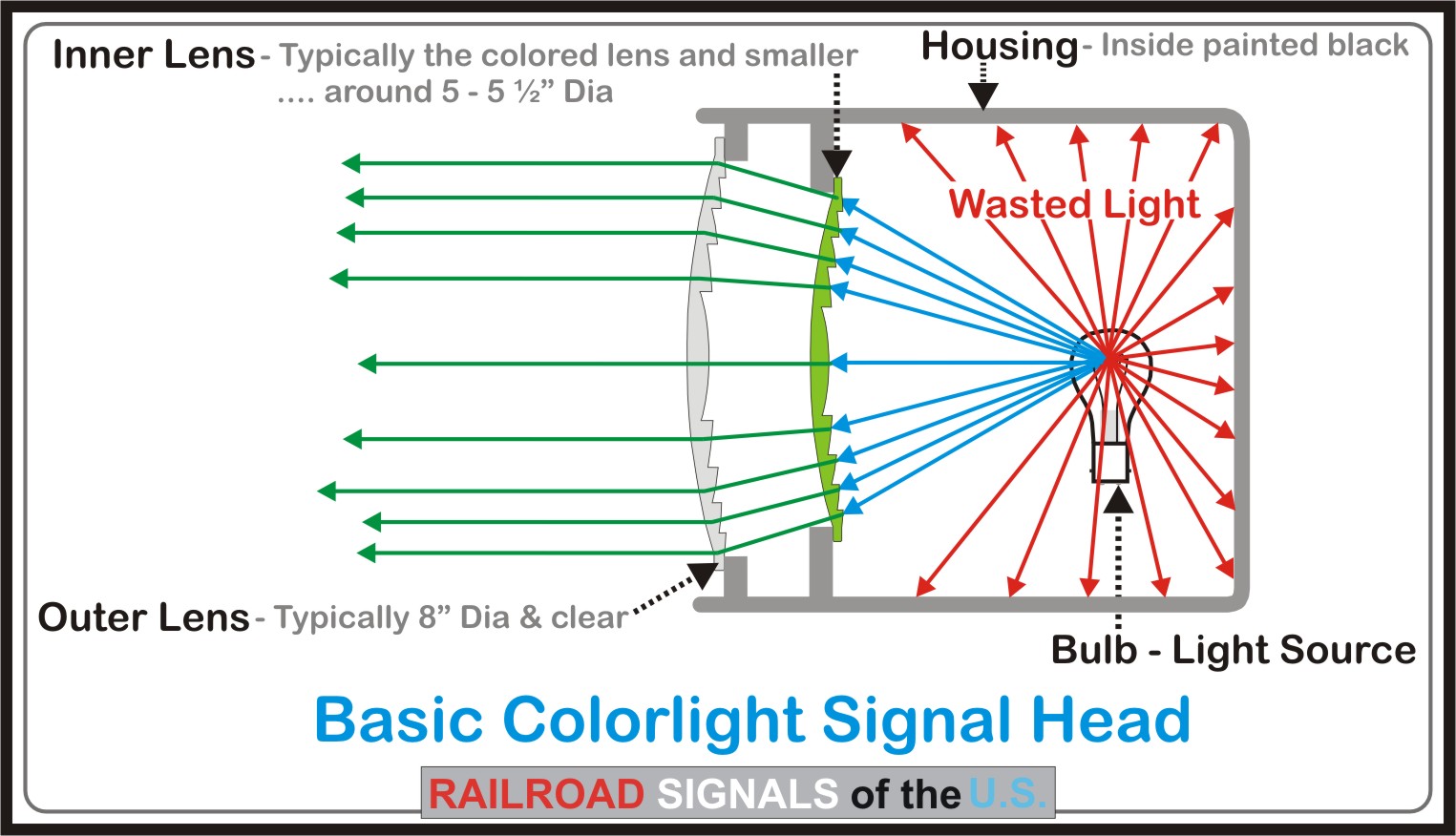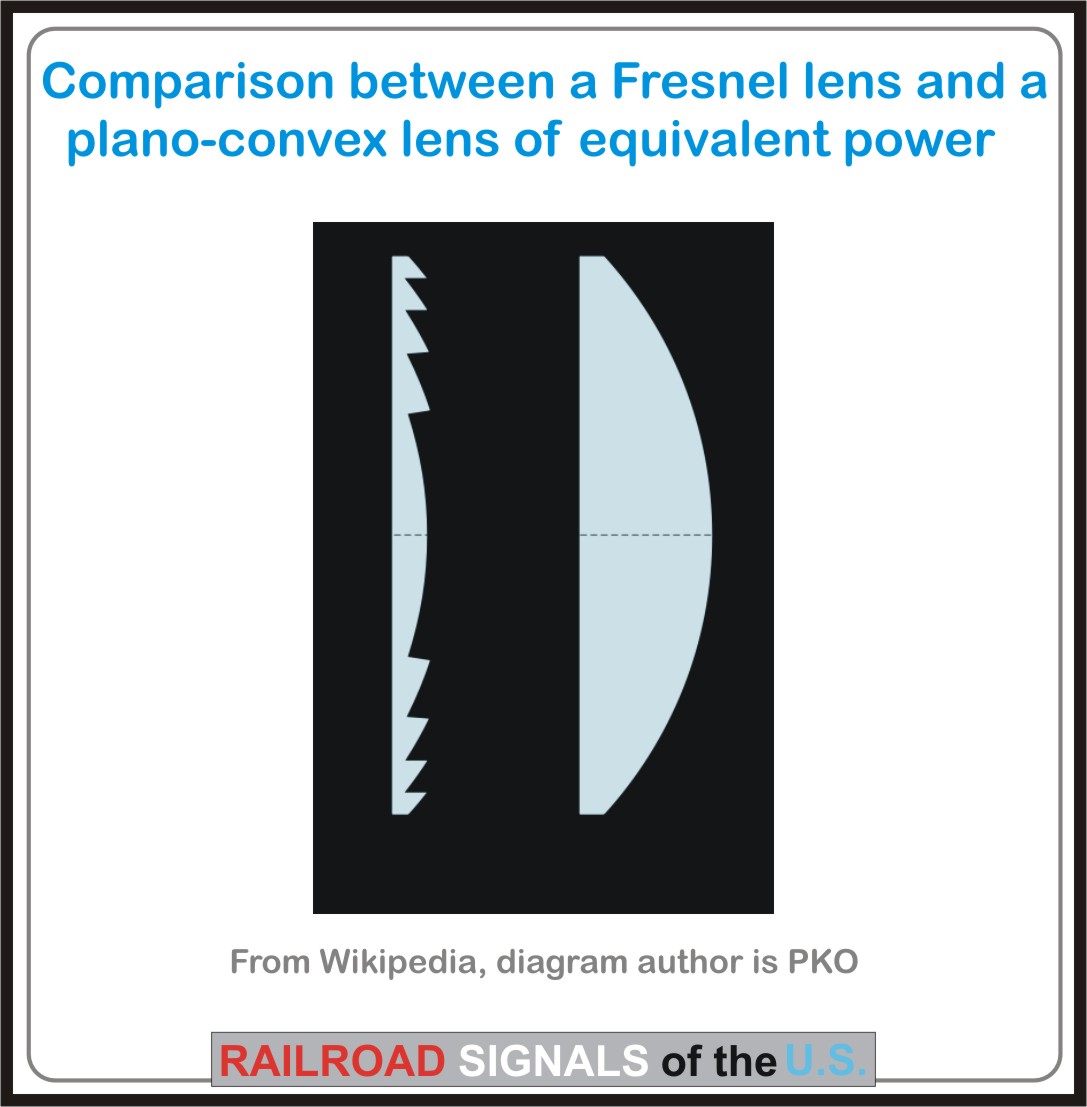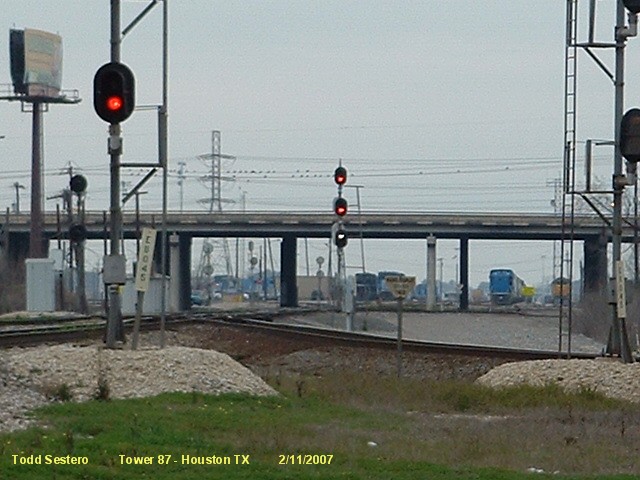
RAILROAD SIGNALS of the U.S.

COLOR LIGHT SIGNALS
Quick Info
Colorlight signals make up the bulk of railroad signals today, and probably every new installation is done with them.
Most of the class 1 railroads have been in
the process of replacing older style signals with colorlights.
The UP, NS, BNSF, and CSX have all been aggressive in the past few years to
replace both older colorlight signals as well as
other styles they have deemed "obsolete", such as CPL's,
PL's, searchlights, and the few remaining semaphores.† For instance, when I was in
The signals at Halethorpe and St
Denis MD in 2007 before being placed into service. Way off in the distance is
the CPL bridge being replaced. The MARC train is DC bound, and you can
also see the new track going in, which is what prompted the signal project.
 Most new
installations going in today have what we jokingly refer to as the "Darth
Vader" style, where all two, three or four lenses are covered by one hood,
instead of the traditional smaller hood for each lens. While they do look
pretty ugly, these hoods are designed to keep snow buildup during inclement
weather almost non-existentÖ they also have the extra advantage of keeping
light out of the lens from the side more effectively.
Most new
installations going in today have what we jokingly refer to as the "Darth
Vader" style, where all two, three or four lenses are covered by one hood,
instead of the traditional smaller hood for each lens. While they do look
pretty ugly, these hoods are designed to keep snow buildup during inclement
weather almost non-existentÖ they also have the extra advantage of keeping
light out of the lens from the side more effectively.
The colorlight style of signals can include 1, 2, 3, or 4 aspect vertical (and horizontal) signals, as well as those that are arranged in a triangular fashion (which some of us refer to as tri-light signals).
Colorlight signals come in a variety of case styles, and today are predominantly modularized so the railroads can stack any number of them together to display as few or as many aspects as needed. In the past the housings were heavy one piece cast iron affairs, which needed a lot of maintenance to keep them from rusting. Today, most of them are fashioned out of aluminum which tends to resist the elements better.
The photo at the top of the
page is of a two-aspect US&S signal protecting the
Colorlight signal are versatile, and they can easily be stacked
to have more than one head for each signal.†
A color light signal can be as simple as a single aspect approach signal,
such as the one shown in
This photo is in Doswell VA. It shows a four aspect colorlight signal, with the lunar "restricting" aspect just above the red.
These two photos are on the CSX in Cumberland MD. The left one shows quite a mix, with single, dual, and triple aspect heads. Also, the head in the middle is probably a newer head, for it has a narrow background compared to the other two, and it has the Darth Vader hood. Even though it looks like a newer installation because of the pole, this was probably on the Western Maryland and they re-used the top and bottom heads, as the WM was a big believer in using the wider backgrounds. The pix on the right is on a three track ex B&O main in town and shows the use of red in the top position.
Although red is generally associated with
the bottom position of a colorlight signal head, there is nothing to say that it has to be that way.† The
Interestingly enough, the majority of
railroads employed colorlight signals in the vertical
position.† The only example I can think
of offhand that didnít, is the CNW, which used
horizontal signals.† Again, some transit
systems would mount the signals wherever they could in the case of close
clearances, and I saw many a signal on the
There is a separate page to cover the
"tri-light" style colorlight signals: click here.
History
According to Brian Solomon in his book Railroad Signaling, colorlight signals made their first appearance in the East Boston Tunnel in 1904. In 1905, they appeared on the Long Island RR, and in 1906, on approaches to New York Centrals Grand Central Terminal which was in the process of being electrified. They first showed up in tunnels because high brightness was not a requirement.
Colorlight signals had to wait for the introduction of a convenient, if not cheap and reliable light source: the incandescent light bulb.† According to most sources, this didnít happen until 1914, when a concentrated filament bulb was developed, giving the color light signal an acceptable sighting distance. Once the signals could be seen for 4,000 feet, during the day, signal designers started using them all over the place.
The colorlight signal also had to wait for advances in lens technology AND clearer lenses to be developed.
Advantages of the colorlight signal over other forms of signaling includes having the same indication during both days and nights, and no moving parts, making maintenance way simpler.
US&S developed the TR-2 style colorlight, where the lenses were arranged in a triangular fashion, in 1924. They are nick-named tri-lights by some. Placing the signals in this format reduced the effective size of the signal, mostly in height.
Itís interesting to note, that by this
time,
FYI, according to Solomon, the automobile traffic light was adapted from the colorlight railroad signal.
More Coming......
How They Work
Colorlight signals are simple in concept and design. There really isn't that much to them.†
For each color of a colorlight
signal, there is a bulb as a light source.†
In some instances, such as rapid transit signals, there may be two lamps
for each aspect, one acting as a back-up in case the main bulb failed.† Most bulbs operate off low-voltage AC, such
as 8, 10, or 12 volts, and utilize an automobile sized bayonet base lamp which
can have either a single or double contact base.† Again, in certain instances such as transit
applications, the bulbs will operate off 120VAC, and utilize a standard size
The light from the bulb is usually focused
by a pair of lenses, usually referred to as a doublet.† One of the lenses is colored, and itís usually
the inner lens.† The inner lens is almost
always a Fresnel lens, which has the advantage of being able to focus the light
beam, but not being as thick as a regular convex lens.


Most, but not all signals, DO NOT employ a reflector behind the bulb, and colorlight signals are no exception.† This is so incoming light, whether it be from an approaching engine, or from the sunlight, does not get reflected back out and the signal appear illuminated.
The signal on the left is one
from the New York City Subway system I picked up at the train show in
Gaithersburg MD several years ago. Notice that it doesn't have any hoods
since it was used in a tunnel. It operates off 120VAC. The
searchlight and dwarf CPL are running off a 12V garden transformer.
Itís interesting to note, that in the old
days on the Pennsy, the signal maintainers had their
hands full at dusk and dawn, going out to adjust the taps on the transformers
to adjust the brightness on the bulbs so they maintained a more or less
constant brilliance in relationship to the sun.†
This must have been fun in the bad weather.† I know they did this on the Position Light
signals, but I am not sure they did it for other types of signals.
In recent years, there has been a trend to
replace the fairly reliable incandescent lamp with LED lamps.† Iíve seen some of the Amtrak PCLís on the
corridor around
Above is a small sampling of LED signals being used today. Photo 1 & 2 are on the MARTA Metro system in Atlanta, notice that they use traffic light placement and further back in the yard, two aspect signals are used. I also understand they have a few four aspect signals with lunar white, but I didn't come across any in my short visit. MARTA uses nothing but LED's. Photo 3 is a tri-light version of a colorlight signal which can be found on the Northeast Corridor around Havre de Grace MD, replacing a set of position light signals.
GOT ANYTHING TO ADD.... PLEASE SEND IT TO: toddgp30@yahoo.com
Other Pictures of Colorlight Signals
For additional pictures, check
out the links below
Doswell VA
These photos
are in Doswell VA at the ex RF&P/C&O diamond there - it's all CSX now.
The "big" photo is the backside of a set of signals for SB trains heading into
Richmond, before it hits the diamond here. It shows how signal designers will mix heads when only one or two
aspects need to be shown. The thumbnails are of a new installation on the
C&O track, with a CSX freight heading westbound out of Richmond. CSX still
runs left hand traffic, as the RF&P did, hence the signal on the "left" capable
of more aspects. Back in 2007, CSX installed new signals at most location
at the diamond, except for the one on the left - they are Safetran modularized
color light signals. I believe they did this because they moved a
crossover several hundred feet to the south. The telephoto pix on the
right is taken from the overpass just down from the 95 exit. The freight
on the diamond is SB on it's way to Richmond. For more pix (and a map) at
Doswell: https://railroadsignals.us/diamonds/doswell.htm
Durham NC
These are fixed approach signals along S. Hoover Road, just off Angier Ave. It's for an NS branch line that goes up to Oxford and Henderson. The signal is on the top, or north end of a wye, west leg.
Gaithersburg MD
Photos of a relatively new
installation on the CSX in Gaithersburg MD (these pix are from August 2007) which
illustrates several points about new installations: The modular
construction of the signal housing can be clearly seen in the middle photo, and
on the left, it shows how signals no longer have to be located to the right of
the track due to relaxed FRA rules on signal placement.
Galveston TX
A dual head colorlight signal on
the north end of the bridge going over to Galveston Island, shared by BNSF (ex
ATSF) and UP (ex SP).
Classic Signal bridge in Gastonia NC
This
signal bridge in Gastonia is located just off interstate 85 at exit 19, Ozark
Ave. South from 85, Ozark turns into Long, keep going south to Rhyne St
and take a left, and another left at the tracks, go north along the tracks till
you can't go 'no further.
Houston TX, Tower 87


These two signals, located only
a couple hundred feet from each other, illustrate what engineers have to put up
with today in the world of "mega-mergers", as they both show restrict.
It's all Union Pacific now, but it used to be UP and SP not too long ago.
For more pictures of this junction:
https://railroadsignals.us/tower87.htm
Lorton VA
Just on the other side of
the road from the Amtrak Autotrain terminal are these signals, easily accessible
of Gunston Cove Rd and I95.
The Autotrain siding comes out onto the NB mainline track, as CSX still runs the
RF&P way, reverse traffic. The first crossover to get it on the correct
side isn't till below Woodbridge, about 5 miles south. The intermediate
signal is typical of the new installations along the RF&P. The cantilever
bridge holds signals for the Amtrak Siding, and for reverse SB traffic.
The picture on the bottom right shows a medium clear for the Autotrain.
The Autotrain leaves each terminal at 4:00pm, and arrives at 9:30am the
following morning, with a run of 855 miles between Lorton and Sanford - it goes
thru Doswell (above) around 4:45 or so (SB).
Ohio
Every year, my friend Jim Mihalek from Minnesota treks to Ohio where he grew up to document the signals there. Here are some pictures from those efforts.
Right photo at Shinrock, mp232. 2008.
East End Avery, which is
easily accessible off Hoover Rd, via Milan Rd and E. Mason Rd. Milan is
exit 118 off the Ohio Turnpike. The west end of the siding is off Kelly
Rd. We're about 45miles west of Cleveland on the NS, ex NKP, mp235.
2008
Point of Rocks MD
Well entrenched in what used to be hardcore B&O CPL territory is this fairly new colorlight installation at the ex B&O station, now used by MARC. Note that red occupies the second position up, as contrasted by the 4 aspect signal in Doswell, shown above.
Salisbury NC
This WB/SB color light signal is located adjacent to the station in Salisbury, just down the road a ways from the Spencer Shops Museum. The signal is GRS, the base is by Modern Industries.
A couple of outbound signals at the east end of SK yard in Buffalo NY
This is a partial list of places elsewhere on this website where you will find pictures of colorlight signals.
Albert Lea MN
https://railroadsignals.us/diamonds/diamond3.htm
Berea OH
https://railroadsignals.us/guides/berea/berea.htm
Tower 85 in Houston TX
https://railroadsignals.us/tower85.htm
Pierce Junction in Houston TX
https://railroadsignals.us/diamonds/diamond7.htm
Two interchanges in Mason City IA
https://railroadsignals.us/diamonds/diamond5.htm
https://railroadsignals.us/diamonds/diamond6.htm
Houston TX Light Rail Signals
https://railroadsignals.us/houston/houston1.htm
Minneapolis MN
Light Rail Signals
https://railroadsignals.us/minn1.htm
NEW: 10/12/2006
Last Updated:
29-Sep-2009